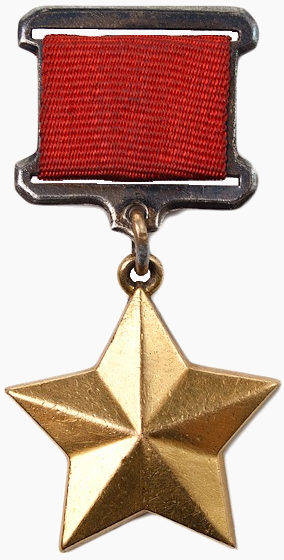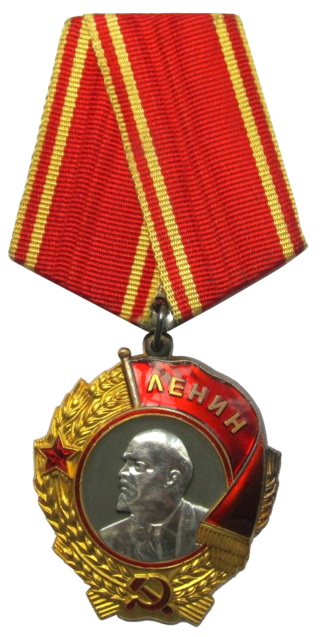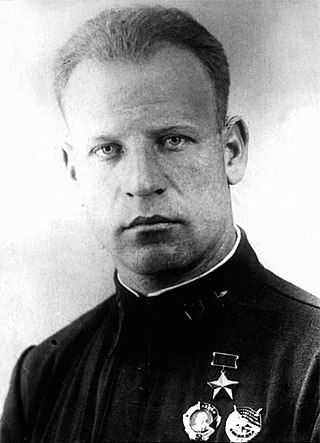Vasily Zaitsev may refer to:
- Vasily Zaitsev (pilot) (1910–1961), Soviet World War II flying ace
- Vasily Zaitsev (sniper) (1915–1991), Soviet World War II sniper
Vasily Zaitsev may refer to:

Snipers of the Soviet Union played an important role mainly on the Eastern Front of World War II, apart from other preceding and subsequent conflicts. In World War II, Soviet snipers used the 7.62×54mmR rifle cartridge with light, heavy, armour-piercing (B-30), armour-piercing-incendiary (B-32), zeroing-and-incendiary (P3), and tracer bullets. Most Soviet World War II snipers carried a combat load of 120 rifle cartridges in the field.

Vasily Grigoryevich Zaitsev was a Soviet sniper during World War II.

Enemy at the Gates is a 2001 war film directed, co-written, and produced by Jean-Jacques Annaud, based on William Craig's 1973 nonfiction book Enemy at the Gates: The Battle for Stalingrad, which describes the events surrounding the Battle of Stalingrad in the winter of 1942–1943. The screenplay was written by Annaud and Alain Godard. The film's main character is a fictionalized version of Vasily Zaitsev, a sniper and Hero of the Soviet Union during World War II. It includes a snipers' duel between Zaitsev and a Wehrmacht sniper school director, Major Erwin König.

The Order of the Red Banner was the first Soviet military decoration. The Order was established on 16 September 1918, during the Russian Civil War by decree of the All-Russian Central Executive Committee. It was the highest award of Soviet Russia, subsequently the Soviet Union, until the Order of Lenin was established in 1930. Recipients were recognised for extraordinary heroism, dedication, and courage demonstrated on the battlefield. The Order was awarded to individuals as well as to military units, cities, ships, political and social organizations, and state enterprises. In later years, it was also awarded on the twentieth and again on the thirtieth anniversary of military, police, or state security service without requiring participation in combat.

The title Hero of the Soviet Union was the highest distinction in the Soviet Union, awarded together with the Order of Lenin personally or collectively for heroic feats in service to the Soviet state and society. The title was awarded both to civilian and military persons.

Lyudmila Mikhailovna Pavlichenko was a Soviet sniper in the Red Army during World War II. She is credited with killing 309 enemy combatants. She served in the Red Army during the siege of Odessa and the siege of Sevastopol, during the early stages of the fighting on the Eastern Front. Her score of 309 kills likely places her within the top five snipers of all time, but her kills may be significantly more numerous, as a confirmed kill has to be witnessed by a third party.
Erwin König was reported to have been a German Wehrmacht sniper killed by the Soviet sniper Vasily Zaitsev during the Battle of Stalingrad. Due to the lack of any Nazi records proving the existence of König and his achievements there is some doubt as to whether he existed at all or was an invention of Soviet propaganda.
Vasili, Vasily, Vasilii or Vasiliy is a Russian masculine given name of Greek origin and corresponds to Basil. It may refer to:

The telnyashka is a horizontally striped undershirt worn as uniform by Russian military personnel. It has stripes in white and in a color that varies according to the unit's affiliation. The most common second color is blue, but a number of other colors are also in use. The garment comes in varying thicknesses and may be sleeved or sleeveless.

Zaytsev or Zaitsev is a Russian last name. It stems from the word заяц. Zaytseva or Zaitseva (За́йцева) is the feminine version of this surname.
Ilyin or Ilin is a Russian masculine surname that is derived from the male given name Ilya and literally means Ilya's. its feminine counterpart is Ilyina or Ilina. It may refer to
Vasili Kuznetsov may refer to:
The Battle of Stalingrad (1942–1943), a battle on the Eastern Front of World War II, often regarded as the single largest and bloodiest battle in the history of warfare, and one of the most decisive battles of World War II, has inspired a number of media works.

War of the Rats is a World War II novel written by David L. Robbins in 1999.

Vasily Shalvovich Kvachantiradze was a top Soviet sniper during World War II. He is credited with confirmed kills numbering at least 215 officers and soldiers of the German Wehrmacht during the Vitebsk-Orsha Offensive and 542 confirmed kills total during the war.
The 284th Rifle Division began service as a standard Red Army rifle division shortly after the German invasion. Moved to the front soon after, it helped defend the Soviet lines west of the Ukrainian capital for more than a month, but was then destroyed in the encirclement of Kiev. A new division was formed in early 1942. It served in the early fighting against the German summer offensive of 1942 until its losses forced it to be withdrawn for rebuilding. In September it was redeployed, and played a leading role in defending the northern part of the central city and Mamayev Kurgan hill in the Battle of Stalingrad, and later in the reduction of the trapped German 6th Army during Operation Ring, for which it was raised to Guards status as the 79th Guards Rifle Division shortly after the battle ended. A third 284th was raised a few months later. It served on the quiet fronts of the Far East for most of the rest of the war before fighting briefly against the Japanese in Manchuria in August, 1945. The unit continued to serve well into the postwar period under other designations.

The Order of Lenin was an award named after Vladimir Lenin, the leader of the October Revolution. It was established by the Central Executive Committee on 6 April 1930. The order was the highest civilian decoration bestowed by the Soviet Union. The order was awarded to:

Vasily Aleksandrovich Zaitsev was a Soviet Air Forces World War II flying ace who was twice awarded the title Hero of the Soviet Union.
Tania Chernova was a Russian-American woman known for serving in the Red Army as a sniper during World War II. She traveled to Belarus to get her grandparents out of Russia, but upon arriving learned that German invaders had already killed them. After that, she joined the Soviet resistance on the Eastern Front, becoming an effective sniper.